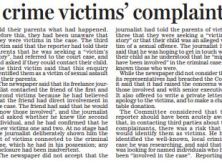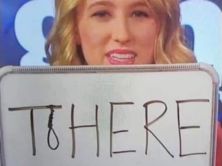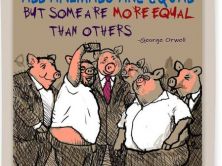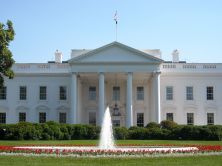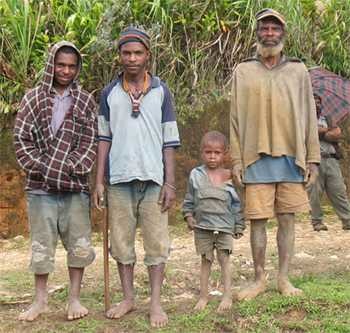
Henep Isum Mandingo, last on right. He is angry that Jared Diamond, reowned UCLA scientist, Pulitzer Prize winner and best-selling author, published "lies" about him in The New Yorker. StinkyJournalism sent three researchers into the Southern Highlands of Papua New Guinea (PNG) starting in July 2008 to fact-check Diamond's article, which ran a year ago today, in the April 21, 2008 issue of The New Yorker. We soon discovered that Henep Isum, an indigenous tribesman who was his main character, was NOT in a wheelchair with spinal paralysis as Diamond dramatically claimed. Yet Diamond wrongly published this error, as well as many others, including charging Daniel Wemp, the indigenous driver he used from the World Wildlife Fund (WWF) for his 2001-2002 bird research, with multiple crimes, including his assertion Wemp was a bloody warrior "thirsting" for revenge who personally paid for killers to do the "maiming of Isum." (credit: Michael Kigl, StinkyJournalism.org)
“The most comprehensive grammatical description of English undertaken from this perspective is the 1,200-page Longman Grammar of Spoken and Written English (LGSWE; Biber et al. 1999).
“…The research for that project is based on analysis of a very large corpus that represents four major varieties: conversation, fiction writing, newspaper writing, and academic writing. For example, the sub-corpus for conversation includes c. 6.4 million words, produced by thousands of speakers. The sub-corpus for academic writing includes 5.3 million words from 408 different texts. Computational / quantitative analyses of these corpora allow us to make strong generalizations about the grammatical characteristics that are frequent or rare in conversation, contrasted with the features that are frequent/rare in academic writing.”
Dr. Biber explained that for his analysis he did a “3-way comparison”:
1.) “a quantitative analysis of the grammatical characteristics of Diamond’s quotes [i.e., the quotations attributed to Daniel Wemp as his spoken words in the 4/21/08 New Yorker article]”
2.) “a quantitative grammatical analysis of Daniel Wemp’s actual speech [verbatim transcripts of speech produced by Daniel Wemp collected by Rhonda Roland Shearer]”
3.) “the research findings from the LGSWE [large-scale corpus analysis of conversation and academic writing].”
Dr. Biber concluded, “Taken together, the linguistic analyses indicate that it is extremely unlikely that The New Yorker quotations are accurate verbatim representations of language that originated in speech. To put it simply, normal people do not talk using the grammatical structures represented in these quotations. However, these quotations do include several grammatical structures found commonly in academic writing, suggesting that the quotations were produced in writing rather than being transcribed from speech.”
Dr. Biber’s analysis revealed that the occurrence of “Adjective and/but adjective (e.g., tall and handsome)” was (emphasis original): “100 times more frequent in Diamond quotes than in speech.”
He also stated that the “Preposition + Relative pronoun (e.g., each battle in which we succeeded in killing an Ombal)” was “100 times more frequent in Diamond quotes” (emphasis original).
He further concluded, “These comparisons show the magnitude of the discrepancies between the grammatical style of normal conversation contrasted with the grammatical style of the Diamond quotes. To find one of these grammatical features in a normal conversation is noteworthy. To find repeated use of this large constellation of features in actual spoken discourse, some of them occurring c. 100 times more often than in normal conversation, is extremely unlikely. In contrast, these are all features that are typical of academic writing, suggesting that they have their origin in writing rather than actual speech.”
In summary, Dr. Biber wrote, “Other corpus studies (e.g., the book University Language; Biber 2006) have shown that these same features are rare and exceptional in even academic speech, including university lectures. In contrast, what we find in the Diamond quotes is the pervasive use of a suite of grammatical constructions, which are all rare in conversation but common in formal writing. This constellation of grammatical characteristics is also strikingly different from the grammatical style of the verbatim transcripts of speech produced by DW [Daniel Wemp]. In sum, the analysis strongly indicates that the Diamond quotes are much more like discourse that was produced in writing, reflecting the typical grammatical features of formal academic prose, rather than verbatim representations of language that was produced in speech.”
What has New Yorker or Diamond done in response to StinkyJournalism’s revelations?
After my initial inquires, and forcing the issue that they had a duty to at least speak to Daniel, (facts which are detailed in my forthcoming 40,000 word report), suddenly, and without advance notice, The New Yorker escalated their stonewalling, and dispatched their in-house attorney, Lynn Oberlander, to write me, instead of their public relations department or editor to address Daniel’s complaint.
When they finally spoke to Wemp, they had the fact checker who failed to do the fact checking in the first place, as the person assigned to call Wemp—one time. The August call did not go well as would be expected.
Oberlander wrote: “I understand that you left a message for one of our fact-checkers, indicating that we missed some potential errors during our discussion with Mr. Wemp. We gave Mr. Wemp several opportunities [in the one phone call, clarification mine] to describe any issues he had with the article, and he seemed quite certain that he had covered everything that was of concern to him; nevertheless, we understand that you believe there are other errors that were not raised.”
The transcript of the actual interview with Jennings contradicts Oberlander’s representation of Daniel’s satisfaction. It provides evidence of Daniel’s claim that he was very upset during the phone call and this clouded his judgment. (Provoked by Daniel’s displeasure, Jennings apologized to Daniel at least three times. Acknowledging there was a problem, he told Daniel, “I’m very sorry that you are in an uncomfortable situation.”)
When Oberlander continued to refuse to fact check me by phone and insisted that my final written report be prepared by September 5, 2008, to meet their deadline for doing corrections that they intended to quickly publish, I temporarily, as an emergency measure, obtained UK lawyers for Daniel Wemp, who soon obtained relief for Wemp who was frantic and wanted the articles down from the Internet as he felt his life was in danger. (A notion that I have since confirmed with multiple experts). Thankfully the article was removed by New Yorker from the Internet, at least for non-subscribers. The lawyers for Wemp also asked the three data bases The New Yorker content is distributed in–Lexis Nexis, EBSCO, Gale Group–to also comply. They did. Only abstracts remain .
Since The New Yorker failed before publication to call these named individuals—a basic fact-checking step—one would think that given their fact-checking procedures, and the seriousness of the alleged errors, that they would be interested in obtaining leads and other information from me so that they could call these people immediately. But no fact checker ever called me or Daniel again, and the editors refused to meet with me, stating, “We’re very busy working on future issues.”
The New Yorker has continued to assert that they have “acted in good faith.” Their attorney wrote, “We have responded with honesty and an openness to collaboration on determining whether there are errors in the article.” However, the historical record—the complete set of email exchanges—proves their behavior is in sharp contrast to their words. Their sacred duty is to “seek the truth and report it” but they fail to do so today, as they did before when publishing overwhelming and harmful errors of fact.
I started off wanting only to verify the facts in The New Yorker article, but the magazine’s and Diamond’s unwillingness to take over the situation when the problems in the reportage emerged and to deal with Daniel Wemp directly, led to my refusal to abandon him in his time of great need. Daniel Wemp would not be in any position to fight for his rights alone. I felt compelled to try to help him. I saw how they previously and conveniently distorted and took out of context part of his statement that his “story is very true,” even after hearing him on tape tell Jennings that Diamond’s version of his story was “inaccurate, inaccurate.”
From their inaction, I could see they did not want to hear the truth, let alone do a serious and independent investigation. If my written report would be the sole source for The New Yorker’s corrections — given their disinterest in pursuing the truth, and their ill-treatment of their main informant by not giving him the respect and proper hearing he deserved — that raised the bar and burden unfairly onto me to do an authoritative report myself, when it was their mess, and their responsibility to investigate and correct their errors.
The Society of Professional Journalists’ SPJ Code of Ethics cites under a major heading that journalists need to: “Seek Truth and Report It” and “Be Accountable.”
Journalists should:
- Test the accuracy of information from all sources and exercise care to avoid inadvertent error. Deliberate distortion is never permissible.
- Diligently seek out subjects of news stories to give them the opportunity to respond to allegations of wrongdoing.
If The New Yorker did not give named tribes and individuals an opportunity to respond before publication, they surely had an even higher obligation to do so after being informed by me that their report had numerous errors. Their journalistic duty is to seek truth. They were told in a September 2, 2008 email from me, “Daniel was not ‘owner of the fight’ for Handas nor was Isum ‘owner of the fight’ for Ombals.” I provided photographs of Isum, showing he stood upright and walked unassisted. I quoted my researcher as stating “only the names and locations are true.”
I also wrote (emphasis original), “I am willing, as I mentioned, to speak to someone there to provide preliminary research results. If recorded and transcribed you are able to circulate it among your stakeholders… To correct the record, I have never refused to detail or respond regarding my assertions of errors.” I further explained, “I am not finished with my investigation but can provide information–have a fact checker–or someone call me (record, transcribe and circulate among you–that’s what I do). I am not a supplicant required to meet your deadlines. I do not have time, desire or ethical obligation to write a footnoted report for you. Dr. Diamond and you need to do your own research.”
So why didn’t The New Yorker or Diamond collect information that I offered in order to contact Isum and the real owners of the fight for their own investigation if they were, in fact, “seeking truth”? The New Yorker has refused to call Wemp again, despite all the verbal and written requests made in his behalf. In his July 17 statement to The New Yorker, Daniel said: “I would at least want Jared on the phone. I would like to talk to him personally so that we could all talk together and sort out this problem so that the article would be removed from The New Yorker because it is very sensitive in my area.”
Despite all academic norms for transparency, scientific requirements for “full disclosure,” and journalistic and academic responsibilities to one’s sources, Diamond has refused to speak to Daniel Wemp. He has not answered any questions about his methods and data since my first email to him on April 30, 2008.
Edward Wasserman, the Knight Professor in Journalism in the Department of Journalism and Mass Communications at Washington and Lee University and well-known media ethicist, said, “In the circumstances you’re describing, he [Diamond] has a real obligation to make it plain to the person he’s talking to, particularly an unsophisticated source, what it is that he’s talking to them for, and what use he proposes to make of the man’s comments … there’s nothing very – you know, subtle about that. That’s a bright line obligation that he has.”
Wasserman added, “Now, all I can say is that if Diamond conducted the interview with this guy without telling what the interview was for, without even telling him it was an interview, then he did something wrong, that the guy has a right to know that he’s talking to somebody for publication, and it really doesn’t matter anymore whether it’s scientific publication or periodical publication, because you have this seamless information network called the Internet, where stuff can be very easily – you know, easily accessed through search engines. So, regardless of whether it was The New Yorker, or The New York Daily News, or some obscure scholarly journal, you still have to tell the guy what this is all about, because everybody has a right to control their words and have some control or some knowledge of what their words or image is going to be used for.”
Consequence for Tribal members of libels
Jack Caldwell, for example, writes in his blog (emphasis mine): “Tribes fighting tribes for control of resources, for revenge, and for the sheer thrill of being young and vicious. Here is a haunting picture from The New Yorker that has just published a superb piece by Jared Diamond in which he traces the deeds of Daniel Wemp in the New Guinea Highlands as he goes about organizing his relatives to kill in order to revenge the killing of his ‘beloved paternal uncle Soll.”’
Jarvis DeBerry, of the Times-Picayune, on December 9, 2008, wrote a column that cited Diamond’s New Yorker article and quotes Daniel Wemp. DeBerry wrote,”Jared Diamond, best known for his book ‘Guns, Germs and Steel’ displays more of his trademark curiosity in an April edition of The New Yorker when he talks to Daniel Wemp in the Highlands of New Guinea about avenging his uncle’s 1992 killing. It took him three years, but Wemp finally made things right by organizing a battle that left his uncle’s killer paralyzed.”
He explained that Daniel “lust[s] for payback” and he justifies violence as a way of becoming a hero. DeBerry quoted Diamond’s article where Daniel described his lack of remorse about harming Isum that DeBerry characterized as “bloodlust”: Daniel said, “I thought, I have everything, I feel as if I am developing wings, I feel as if I am about to fly off, and I am very happy.” DeBerry also cites Daniel’s admission of a crime: “ ‘I wanted to obtain vengeance myself, even if it were to cost me my own life,’ Wemp said. Even if he had died, ‘I would be considered a hero and would be remembered.’ ”
DeBerry concluded, “In New Orleans somebody would have put Wemp’s face on a T-shirt and proclaimed how he kept it gangsta to the very end.” He cites what Diamond wrote in his article that “Daniel’s methods might seem quite familiar to members of urban gangs in America, and. . . peoples of other countries where tribal ties remain strong and state control weak,” and concludes, “If, as Diamond says, the lust for payback is never stamped out in an orderly society, imagine how it must rage here where ‘state control’ is so weak. Imagine what it feels like when people believe that the only justice that exists is the justice they carry out.” (It is surprising that Advance Publications owners of both The New Yorker and Times-Picayune would allow this second defamation to take place in December 2008 after The New Yorker article was removed from their web site.)
Dan Jorgensen, a professor in the Department of Anthropology at the University of Western Ontario, is an expert on Papua New Guinea. He noted that Diamond’s “pig in a garden” debacle has put people at risk. Professor Jorgensen said, “In fact, there are lots of other criticisms one can make and should make about his [Diamond’s] work, but one of the things that is clear is that the guy is not a professional anthropologist, and there are all kinds of things he does, and I regard – your concern about using somebody’s real name, for example – as a big one. And I just automatically assumed, ‘Well, of course it’s not the guy’s real name,’ because nobody would ever do that, right?”
Jorgensen continued, “And see, that’s the kind of thing no professional anthropologist – I mean, that would be default assumption, okay? If nothing is said you automatically assume it’s a pseudonym, and for all kinds of absolutely crucial, ethical reasons, and sometimes people really want you to use their real names.” In this circumstance, a mix of “real names and some pseudonyms are used.” Jorgensen said, “One of the things that upset me more than anything else was the Annals of Anthropology thing there, because that’s not Annals of Anthropology. That’s false advertising.”
Nonetheless, internal evidence in Diamond’s article indicates that he and his editors knew or should have known the dangers of the article for Daniel and the other identified individuals whom Diamond named as having committed serious crimes. The article depicted a violent culture in PNG of never-ending revenge. Diamond quoted Daniel specifically stating how dangerous it is to identify killers. He wrote, “Even if the side achieving the kill does know, it is always careful to keep the killer’s identity secret. For that reason, the target of Daniel’s revenge was not Soll’s killer but another Ombal man, named Henep Isum, who had organized the fight for the Ombals.” Does it, then, make any sense that Daniel would casually identify himself as personally plotting to kill Isum with hired assassins?
Yet Diamond states that this is true, giving the exciting illusion of privileged knowledge; that the man he was talking to—his driver—was a secret killer. However, with publication there is no secret, even in the jungles, due to the Internet. With the information provided in the article, Diamond and The New Yorker editors were aware—or should have been aware—of the dangers for Daniel. Diamond even wrote about the specific risks to Daniel, with total disregard that the article would only compound additional risks. Diamond wrote, “But it continued to concern Daniel, who was now, of course, a target for Ombal revenge. He told me that Ombal men tried for several years to kill him and three other Handa clansmen who had been fight-owners, but they never succeeded.”
The untruths in The New Yorker article by Dr. Jared Diamond are already poisoning the future of indigenous peoples. Mako John Kuwimb, Handa clansman must publish a peer-reviewed paper before being able to finalize his PhD degree after four years of study. The referee notes for Kuwimb cites Diamond’s article as evidence of violence of Handa in SH PNG [Southern Highlands of Papua New Guinea]. The anonymous reviewer suggests that Kuwimb is somehow not honest about his area’s violence (” the actual circumstances of Papua New Guinea today” pg.3 ) and uses Diamond’s article to support this assertion. He/she writes: “The author comes from Handa village (the subject of an essay by Jared Diamond in the New Yorker, 21 April 2008), not far from the production facilities in the oil fields of Southern Highlands Province in Papua New Guinea (not discussed).” (pg.4) The key words are “not discussed.”
He/she goes on to further suggest the fact of the violence of the Handa area (that Kuwimb should know about and should have mentioned) in their conclusion: “The paper neither mentions the conflicts of local origin that have resulted in the rise of a gun culture, failed elections, the destruction of most social services, and the imposition of various States of Emergency over the last decade, nor the local political salve that was apparently agreed to in 2008 by the national government and the Southern Highlands oil and gas owners – to form a new Hela Province in 2010. The Southern Highlands has massive social and political problems, and so will Hela Province, but few can be blamed on legislative drafting dating back 120 years.”
In other words, the only evidence the reviewer offers for this assertion of violence in the Handa area (that he/she suggests Kuwimb should have mentioned as he is a Handa!) is the Diamond article that, in fact, and unbeknownst to the reviewer, is full of untruths and libels.
Why would Kuwimb discuss an un-peer-reviewed article in The New Yorker magazine in the first place? He certainly would not mention it as it is full of objective factual inaccuracies and libelous assertions. And yet there it is, cited in the peer review simply because Dr. Diamond’s and The New Yorker‘s prestige is powerful—and, therefore, extremely dangerous when wrong. They have soiled the reputation of the Handa and Ombals and individual clansmen and they need help to defend themselves. This case could set an example around the world that just because people are indigenous does not mean the powerful can come into their area and export lies about them for profit. (Diamond’s agent was trying to sell lecture bookings using Daniel Wemp’s and the Handa and Ombal’s names and these false stories [of their murderous and raping behaviors along a Hwy as “Nipa tribes people” when they are not Nipas and live 4 or 5 hours away from said Hwy] for $25,000 each).
Let this case be a cautionary tale warning others around the world that such “academic” exploitation will no longer be tolerated and will be exposed by the international community, who will stand up along with the victims of such painful lies.
UPDATE:04/22/09: 9:34am: We corrected the spelling of Mt. Hagen and removed Dr.as title from long time-PNG scholar, Nancy Sullivan’s name. Sullivan explains: “I have a PhD abd, all but dissertation. This simply means it is an un-defended PhD.” We regret the error.
UPDATE:04/27/09:11:26pm : Due to an editing error, John Kuwimb was named George Kuwimb, his brother. (Mako) John wrote the words instead of speaking them. We regret the error.
* Research Methodology? StinkyJournalism vs. New Yorker & Diamond
Pamela Maffei McCarthy, The New Yorker deputy editor, wrote in an August 15, 2008 letter (emphasis mine), “When our first choice of source is not available, we must rely on the next, and in this case we consulted a large number of experts in the various fields the material touches on.”
One of those experts was Alex Golub, assistant professor at University of Hawaii at Manoa, an anthropologist and expert on PNG who writes for Savageminds.org. Golub said that, indeed, a fact-checker spoke to him for “about 15 minutes” and only asked general questions. He said, “They asked me some general questions about what is PNG like and what is tribal fighting like and this kind of stuff, it didn’t have anything to do with the actual case [or] details of the actual case.”
Golub continued, “No one asked me anything about whether the guy was in a wheelchair or any dates or anything like that. It sounds like from what you’re saying that they never really bothered to do that at all at any level.”
In contrast to what The New Yorker apparently did, my method for field work focused on the details. “Could it be true?” was not good enough. “Was it true?” was the clarion call. Either Isum was paralyzed with a spinal injury in a wheelchair or he wasn’t. The mission was clear.
I began that mission by contacting two local indigenous researchers recommended by two American scientists who have worked in PNG for many years. Through PhD anthropologist, Nancy Sullivan, an anthropolgist and consultant who has lived and written about PNG for many years, I was introduced to Divine Word University (DWU) journalism professor Brother Michael McManus. McManus, in turn, suggested I contact his student Jeffrey Elepa whose thesis was on peace and compensation. Elepa was from the Southern Highlands and spoke the dialect. Through environmental scientist Andrew Mack, PhD, who lived in PNG for many years (co-author with Paige West, PNG expert, associate professor of Anthropology at Barnard College and Columbia University; “Ten Thousand Tonnes of Small Animals: Wildlife Consumption in Papua New Guinea, a Vital Resource in Need of Management [.pdf],”, I was introduced to one of his researchers, Michael Kigl) .
Elepa and Kigl did not know each other, and the data they collected were only compared after they completed their research. This was a key component of my research plan. If Elepa and Kigl came back independently with the same or similar stories from the area, the constancy itself would further indicate overall accuracy. I soon added a third researcher, Kritoe Keleba, who worked for Sullivan, just to have a final push for additional informants we were not able to locate previously, and to obtain medical records from Isum and check with the police station about their reports. Keleba did not know my other two researchers.
The goal was to interview multiple informants from all sides (Handa, Ombal, neutral parties). Persons named in Diamond’s article were of special interest as well as the fight “owners” or village leaders. All interviews were to be tape-recorded and photographs taken for documentation when possible. Our team of three field researchers (Michael Kigl, Kritoe Keleba, Jeffrey Elapa), interviewed and verified the article’s numerous errors with 20 sources, a number that includes Daniel Wemp, the actual tribal owners and organizers of the fight and police who worked the 1993 case. Field interviews include two groups of men: one, a Henep group with 23 members, and the other, an Ombal group with 17 members, who acted as a Greek chorus adding comments as certain informants spoke. I personally conducted over 300 phone and email interviews with over 80 anthropologists, scientists and journalists with expertise in ethics and/or Papua New Guinea, as well as indigenous informants.


